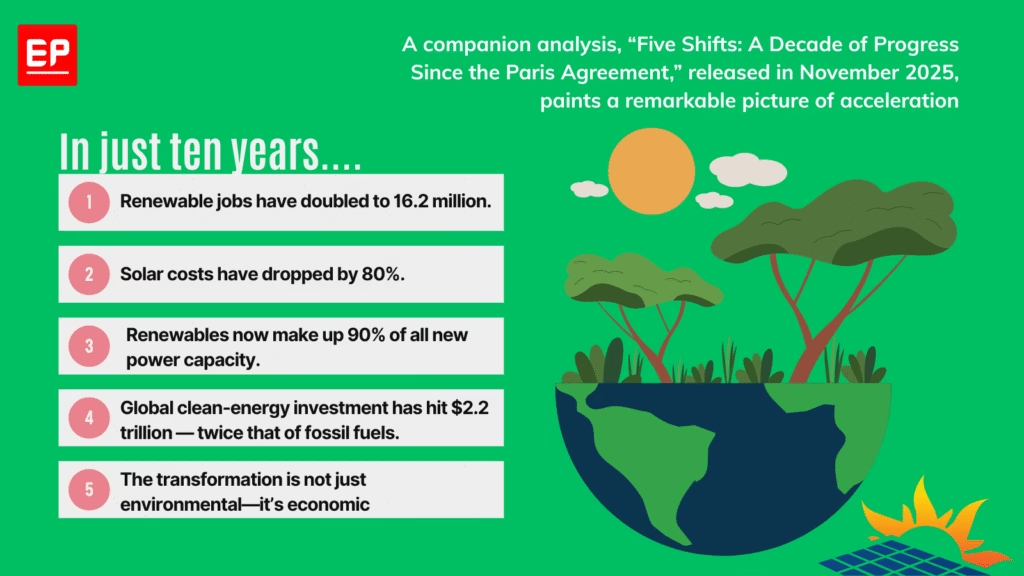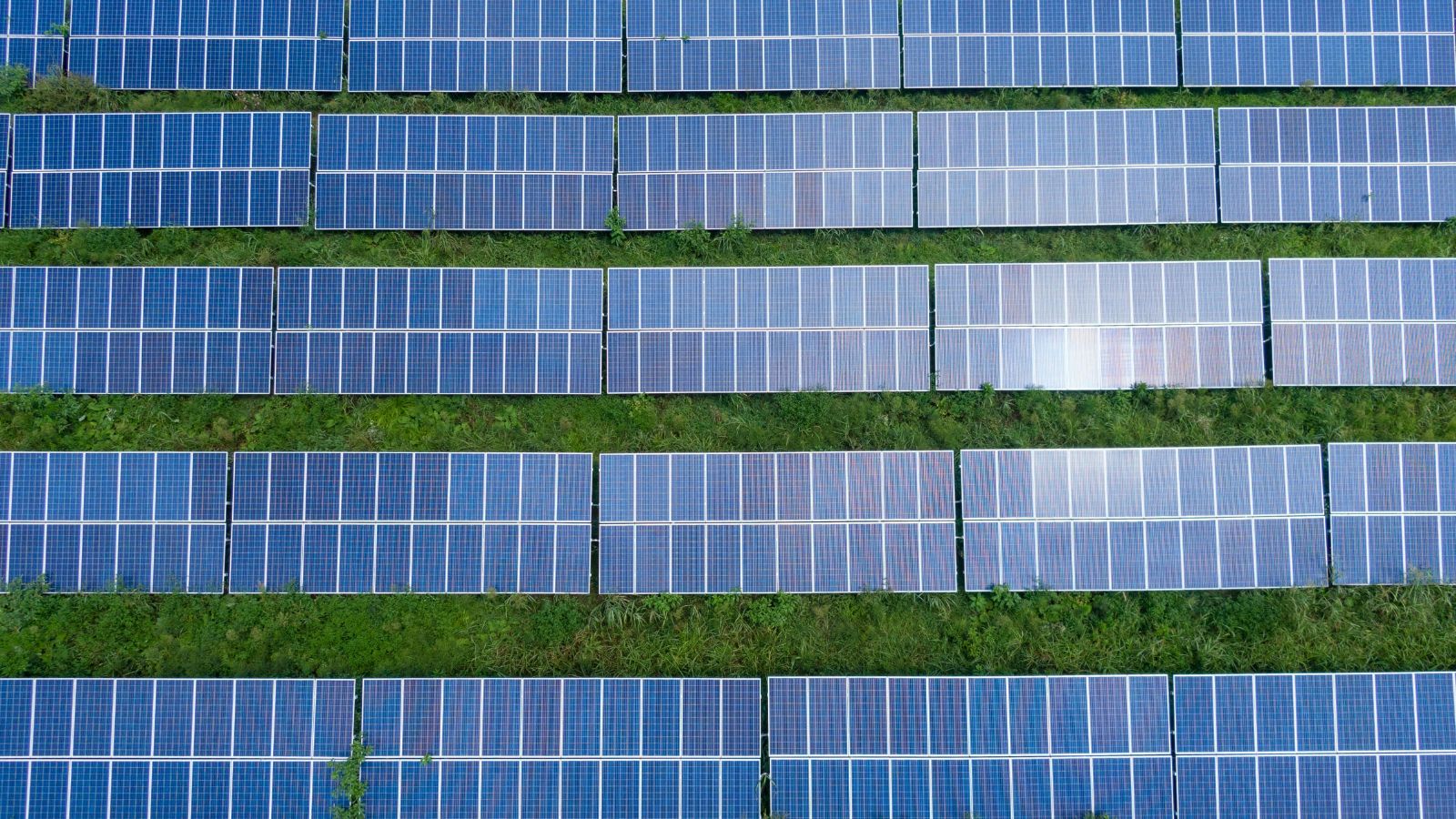COP30
COP30: How People, Not Politics, Are Powering the Next Phase of Climate Action
From rooftop revolutions to billion-dollar clean-energy investments, the global shift toward renewables is already happening — citizens and markets are leading where politics still hesitates.

As the world converges on Belém for the 30th UN Climate Change Conference (COP30), the air is heavy not just with Amazonian humidity—but with expectation. Ten years after the Paris Agreement, the story of global climate action has entered a new chapter. One defined less by negotiation rooms and more by rooftops, communities, and citizens who have already begun to build the future politicians still debate.
A new statement released just a week before the summit, titled “Protect What We Love,” captures this shift. Signed by 75 leaders across politics, culture, and civil society—including Christiana Figueres, Ban Ki-Moon, Mary Robinson, Richard Branson, Stella McCartney, and Dia Mirza—the call to action urges governments to finally transform past commitments into tangible plans.
“You agreed to transition away from fossil fuels. You agreed to halt and reverse deforestation. You agreed to mobilize finance for adaptation and mitigation in developing countries,” the statement reminds world leaders. “At COP30, we ask you to show us how—through concrete plans and timelines—so that we can protect the people and places we love.”
This appeal comes amid fresh global polling data showing what the authors call “the 89%”—an overwhelming majority of citizens worldwide who want faster climate action. The findings, by the Potential Energy Coalition, reveal that eight in ten people across ten countries support government investment in wind, solar, and nuclear energy—double the number backing fossil fuels. And notably, that support transcends politics. Even conservatives, often framed as skeptics, are 1.6 times more likely to favour clean-energy investment than fossil fuel subsidies.
A Decade That Defied Predictions
That popular consensus coincides with new evidence of real progress. According to “Five Shifts: A Decade of Progress Since the Paris Agreement,” released in early November 2025, the world has made more headway in clean-energy deployment and policy integration than most experts dared to expect back in 2015.
In the decade since Paris, renewable energy jobs have nearly doubled to 16.2 million, and annual clean-energy investments reached $2.2 trillion—twice that of fossil fuels. Ninety percent of all new power capacity added globally in 2025 came from renewables. Solar costs have plummeted by 80% since 2014.
The transformation is not just environmental—it’s economic. “The fossil fuel industry knows that the new economy is rising,” said Christiana Figueres, one of the architects of the Paris Agreement. “They know that they can no longer compete. We are no longer in a world in which only climate politics has a leading role, but increasingly climate economics.”

That’s a profound shift in the centre of gravity. In 2015, climate action depended on international consensus. In 2025, it increasingly depends on investment logic.
From Pledges to Proof
Still, COP30 will test whether politics can keep pace with the real world. “It’s a different kind of COP than we’ve had before,” said Jennifer Morgan, Germany’s Special Envoy for International Climate Action. “It is one where there’s not one big fund or one big outcome. One really needs to be looking at the signals, the decisions, and the proof points to see how leaders and countries are accelerating implementation—because that’s what this is all about: going faster, going further, building on the success, learning the lessons of the lack of success.”
The Five Shifts report echoes that sentiment. Its authors warn that while clean energy is winning both economically and politically, emissions are not yet falling at the speed required. The UNEP Emissions Gap Report 2025, published days before the summit, estimates that even with full implementation of current national climate plans (NDCs), global warming would reach 2.3–2.5°C, and 2.8°C under existing policies.
$2.2 trillion in clean-energy investment in 2025 — twice fossil fuels
The world is already 1.35°C warmer, with extreme heat events multiplying by a factor of nine since 2015. Yet the same report highlights practical successes: half of all countries now have heat-warning systems, and 47 operate national heat action plans, saving lives in cities from Senegal to Japan.
For Bill Hare, CEO of Climate Analytics, the takeaway is simple: “The world can still return to well below 1.5°C if the highest possible ambition is pursued by countries starting now. Getting to net zero carbon dioxide emissions means that we can halt warming pretty quickly.”
Citizens Are the New Climate Majority
What distinguishes COP30 from the summits before it is not just scientific urgency—it’s civic clarity. As the Protect What We Love statement declares, “We are the 89%: the overwhelming majority of the global population who want you to act faster on climate change.”
That human dimension is front and centre. Leanne Brummell, representing Parents for Future Global, spoke for millions of families when she said:
“As parents, our first duty is to protect our children. The climate crisis is a direct threat to their safety and their future… We are part of the 89% of people globally who want to see their governments take more action to protect the places and people we love.”
The emotional urgency resonates far beyond activist circles. Dia Mirza, actor and UN advocate, said: “As a mother, I see the truth of today’s statement in my children’s eyes every day. People everywhere are rising to build, buy, and create the solutions that will keep our children safe. Public support for climate action is undeniable, and the technology and answers already exist. At COP30, I ask world leaders to act with the same instinct every parent has—to protect what we love most: our children and their future.”
This groundswell of public will is now being matched by business leadership. A new E3G poll found 97% of global executives backing a rapid transition to renewable-based electricity. Major corporations have joined the We Mean Business coalition, urging governments to create policies that reward decarbonization rather than delay it.
“Climate breakdown is no longer a distant risk for business—it’s already disrupting operations through extreme weather events such as floods and droughts,” said Fiona Duggan, Global Sustainability Manager at Unilever. “Forward-thinking companies are moving to adapt and decarbonise as rapidly as their sectors will allow. The real question is whether governments will support them to go further, faster.”
Constructive Pathways: What’s Working
A decade of experimentation has produced more success stories than cynics expected. Countries once seen as dependent on fossil fuels—Nigeria, Senegal, Brazil, Indonesia—are embedding climate action into fiscal and planning systems. Nigeria’s 2021 Climate Law supports a 2060 net-zero target; Senegal’s local experts now drive national adaptation plans; Brazil’s Finance Ministry leads an Ecological Transformation Plan linking fiscal reform with green growth.
According to Henri Waisman, Director of the DDP Initiative, “Countries have begun to reshape climate governance, embed long-term perspectives into policymaking, and accelerate technological change. This progress is significant. But the lesson of the past decade is equally clear: if we are to achieve the goals of Paris, the next decade must be about scaling up efforts, addressing social and industrial challenges, and ensuring that ambition is consistently translated into effective action.”
These local models, backed by citizens’ trust and economic dividends, suggest that climate action isn’t just a moral imperative—it’s a viable development strategy.
The Belém Moment
If there’s a unifying message emerging from Rio’s press releases to Belém’s plenary halls, it’s this: the transition has already begun.
Citizens, investors, and innovators are not waiting for permission. “Ordinary people understand that clean energy will improve their lives and have begun the transition their leaders keep promising,” said environmentalist Bill McKibben. “Rooftop by rooftop, community by community, they’re proving the future can arrive before the politics to govern it.”
COP30 thus becomes less about what to agree upon—and more about how fast to deliver what’s already agreed. The Five Shifts report puts it succinctly: “COP30 must move beyond pledges to concrete delivery: addressing the ambition gap in current NDCs, accelerating finance for adaptation, and ensuring just transitions away from fossil fuels. The decisions made in Belém will determine whether the 2030s become a decade of decisive implementation.”
From Political Will to Public Proof
Ten years ago, in Paris, climate ambition was an act of collective imagination. In Belém, it’s a lived reality, visible in data, rooftops, and balance sheets. The clean-energy revolution is no longer hypothetical—it’s happening.
The challenge now is whether governments will catch up with their citizens. Because, as the 89% have made clear, the mandate to act isn’t waiting for another conference. It’s already out there—building, investing, and protecting what we love.
COP30
From 6% to 16%: The Philippines Shows the World How Fast Climate Budgets Can Shift
In just four years, the Philippines has expanded its climate spending from PHP 282 billion to over PHP 1 trillion — one of the fastest fiscal shifts anywhere in the world.

Governments across the world are beginning to rethink the way national budgets are designed, moving away from traditional fiscal planning and toward systems that integrate climate considerations directly into spending decisions. A new comparative review of global green-budgeting practices reveals a trend that is gathering momentum: more countries are using their budgets as climate-governance tools. But the pace of progress varies sharply between advanced economies and emerging markets.
The Rise of Climate-Conscious Budgets
Countries such as France, Ireland, Mexico and the Philippines provide some of the clearest examples of how climate priorities are reshaping national expenditure. France has increased its identified climate-positive budget from €38.1 billion in 2021 to €42.6 billion in 2025, while Ireland expanded its environmental allocations from €2 billion (2020) to €7 billion (2025). Mexico’s transformation has been even more rapid: climate-related expenditures rose from MXN 70 billion (2021) to MXN 466 billion (2025) — a six-fold increase.
A Sudden Surge in the Philippines
Nowhere is the shift more dramatic than the Philippines. After embedding climate budget tagging across its ministries, the country’s climate budget expanded from PHP 282 billion in 2021 to more than PHP 1 trillion in 2025, raising its share of the national budget from 6% to 16%. The reform forced ministries to assess thousands of programmes through a climate lens, resulting in a shift toward resilient infrastructure, sustainable energy, water security, and climate-smart industries.
Advanced Economies Move Beyond Tagging
While emerging economies are scaling up climate allocations, advanced economies are integrating climate metrics deeper into fiscal systems. Canada’s “climate lens” requires greenhouse-gas and resilience assessments for major infrastructure projects before funding is approved. Norway links its annual budget to its Climate Change Act and long-term low-emission strategies. Germany uses sustainability indicators to guide fiscal decisions, embedding climate considerations into macroeconomic planning.
These tools go beyond transparency. They force ministries to justify public spending not only in economic terms, but in climate terms — shifting budgets from accounting documents to steering instruments.
Despite this momentum, the analysis notes a persistent gap: many countries stop at tagging climate-related expenditures without linking them to outcomes or performance indicators. Tagging improves transparency, but on its own does not change investment decisions. Without climate-based appraisal and monitoring, high-emission infrastructure can still slip through national budgets unchallenged.
The Financing Challenge
For lower-income countries, the largest barriers are financial. High capital costs, limited fiscal room, and weaker public financial management systems restrict the scale of green budgeting reforms. Even when climate spending rises, sustaining these increases requires integrating climate metrics into medium-term fiscal frameworks — something only a handful of emerging economies have attempted.
Innovations Show What’s Possible
Some models offer a blueprint. Indonesia’s climate-tagging system feeds directly into its sovereign green sukuk framework, giving investors clear visibility over the use of proceeds. This loop — tagging, reporting, financing — demonstrates how governments can leverage green budgeting to unlock larger pools of private capital.
Still in Progress
The report concludes that the next frontier for green budgeting is integration: linking budget tagging, climate-lens project appraisal, performance-based reporting, and climate-aligned fiscal strategies. Done together, these tools allow budgets to become climate-governance instruments capable of guiding national transitions.
But the pace remains uneven. Some countries are racing ahead, while others are taking incremental steps. What is clear, however, is that climate-aligned public finance is no longer optional. As climate impacts intensify, the alignment of the world’s budgets will determine who adapts — and who is left behind.
COP30
Clean Energy Push Could Halve Global Warming by 2040, New Analysis Shows
A new Climate Action Tracker analysis shows that tripling renewables, doubling energy efficiency and cutting methane could halve global warming by 2040

A rapid global shift to renewable energy, energy efficiency and methane cuts could halve the rate of global warming by 2040, dramatically altering the world’s climate trajectory, a new Climate Action Tracker (CAT) assessment finds.
The analysis shows that implementing the three core COP28 energy and methane goals—tripling renewable energy capacity, doubling energy efficiency improvements, and delivering steep methane cuts by 2030—would bring down projected warming from the current 2.6°C to 1.7°C by the end of the century.
Crucially, these actions would sharply slow near-term warming, reducing the pace of temperature rise by a third by 2035 and nearly half by 2040, compared to today’s rate of ~0.25°C per decade. This slowdown is critical not just for long-term climate goals but for immediate survival, the report stresses.
A Turning Point
The world is already struggling to cope with accelerating climate impacts. With ecosystems collapsing faster than species can adapt and communities facing worsening heatwaves, storms and crop failures, “catching up” on adaptation has become a global emergency.
CAT warns that under current policies, warming could continue rising throughout the century, leaving governments perpetually behind on adaptation planning. But halving the warming rate would give both people and ecosystems a fighting chance to adjust.
A 0.9°C Improvement in the Global Outlook
If all countries implement the three goals, the resulting emission cuts—14 GtCO₂e by 2030 and 18 GtCO₂e by 2035—would reduce expected warming this century by 0.9°C, one of the most significant improvements since the Paris Agreement.
“This is the single biggest step governments can take this decade, using goals they have already negotiated and agreed to,” the report notes.
Where the Reductions Come From
- Tripling renewables: ~40% of total emission reductions
- Doubling energy efficiency: ~40%
- Methane cuts: ~20%, but delivering disproportionate warming benefits due to methane’s strong short-term impact
Finance Is the Missing Link
The report underscores that technology is not the barrier—finance is. Many emerging economies cannot deploy renewables or upgrade grids at the necessary pace without scaled-up international support.
Still, the authors say the pathway is feasible and grounded in technologies already available at commercial scale.
While the world is almost certain to overshoot 1.5°C by the early 2030s, the duration and magnitude of that overshoot will determine future levels of loss and damage. Delivering the COP28 energy and methane goals, the report concludes, is the most powerful tool the world currently has to limit that overshoot and avoid runaway climate impacts.
COP30
Health Systems ‘Unprepared’ as Climate Impacts Intensify, Experts Warn at COP30
India will require $643 billion between now and 2030 to adapt to climate change under a business-as-usual scenario

On Health Day at COP30 (November 13), global health and climate experts warned that the world is dangerously underprepared for the accelerating health impacts of climate change, calling for a dramatic scale-up of adaptation finance to protect vulnerable populations.
Speaking at a press conference hosted by Regions4, the Global Climate & Health Alliance and CarbonCopy, leaders from research institutions and national governments said climate-linked health threats — from extreme heat to wildfire smoke — are rising sharply while funding remains “colossally” insufficient.
“Each year, more than half a million lives are lost due to heat, and over 150,000 deaths are linked to wildfire smoke exposure,” said Dr. Marina Romanello, Executive Director of the Lancet Countdown. “Health systems, already stretched and underfunded, are struggling to cope with these growing pressures, and most are still unprepared for what is coming.”
Romanello added that despite the scale of the crisis, “only 44% of countries have costed their health adaptation needs, and existing finance falls short by billions. Without urgent investment, we will not be able to protect populations from escalating climate impacts.”
Adaptation gap continues to widen
The speakers described health-sector underfunding as a critical part of the broader adaptation finance gap. The latest UNEP Adaptation Gap Report estimates developing countries will need $310–365 billion annually by 2035, while the international community is still struggling to mobilise even the $40 billion Glasgow Pact Goal.
“With regards to finance, the reality is that we have a deficit that is quite colossal,” said Carlos Lopes, Special Envoy for Africa, COP30 Presidency. “Most of the efforts are from national authorities. What we need from international finance is that it must be complementary.”
Lopes cautioned that climate and health policy still operates in “multiple contested layers,” warning that unless these are aligned, “we risk losing coherence in our global response.”
Countries highlight urgent needs
Representatives from Bangladesh, Nigeria, India and Chile echoed concerns that adaptation finance is far from matching on-ground needs.
“Our adaptation financing for health is far below what is needed. The gap between what we require and what we receive is enormous,” said Md Ziaul Haque, Additional Director General, Ministry of Environment, Bangladesh. He urged multilateral finance entities to bring forward “concrete, holistic proposals that match the scale of the challenge.”
Nigeria’s challenges are equally stark. “In Nigeria, we are facing an additional 21% disease burden due to climate change… yet the adaptation finance we received in 2021–22 only met 6% of our needs,” said Oden Ewa, Commissioner for Special Duties and Green Economy Lead. He called adaptation finance a “lifeline that saves lives, strengthens communities, and protects economies.”
India outlines its adaptation burden
India also presented updated estimates of its climate adaptation needs. “India will require $643 billion between now and 2030 to adapt to climate change under a business-as-usual scenario,” said Dr. Vishwas Chitale of the Council for Energy, Environment & Water. He noted that India has already made “significant progress, spending $146 billion in 2021–2022 alone — 5.6% of GDP.”
New funding coalition signals momentum
Speakers highlighted the launch of the Climate and Health Funders Coalition, which has committed an initial $300 million annually.
“This is an encouraging signal… It shows that the world is beginning to recognise that protecting health must be at the centre of climate adaptation,” said Jeni Miller, Executive Director, Global Climate & Health Alliance.
Health at the centre of adaptation
Chile stressed the need for integrated policy approaches.
“It is vital to combine the efforts of different ministries — not only health but also transport, energy and food production — so that we generate co-benefits across sectors,” said Dr. Sandra Cortes, President of Chile’s Climate Change Scientific Committee. “A more integrated approach will allow us to improve public health, reduce emissions and create fairer, more sustainable development opportunities.”
As negotiators continue discussions in Belém, experts reiterated that adaptation finance — especially for health — must be just, equitable, accessible and prioritise the most climate-vulnerable nations. The recently proposed Belém Health Action Plan and the Global Goal on Adaptation are expected to serve as frameworks for strengthening health system resilience worldwide.
-

 Know The Scientist5 months ago
Know The Scientist5 months agoRemembering S.N. Bose, the underrated maestro in quantum physics
-

 Space & Physics4 months ago
Space & Physics4 months agoJoint NASA-ISRO radar satellite is the most powerful built to date
-

 Society5 months ago
Society5 months agoShukla is now India’s first astronaut in decades to visit outer space
-

 Space & Physics4 months ago
Space & Physics4 months agoNew double-slit experiment proves Einstein’s predictions were off the mark
-

 Society6 months ago
Society6 months agoAxiom-4 will see an Indian astronaut depart for outer space after 41 years
-

 The Sciences5 months ago
The Sciences5 months agoHow a Human-Inspired Algorithm Is Revolutionizing Machine Repair Models in the Wake of Global Disruptions
-

 Society6 months ago
Society6 months agoWhy the Arts Matter As Much As Science or Math
-

 Earth6 months ago
Earth6 months agoWorld Environment Day 2025: “Beating plastic pollution”






































Pingback: Beyond Politics: Citizens and Cities Take the Lead in Global Climate Action – EP NEWS